Alessandro Achille
PICASO: Permutation-Invariant Context Composition with State Space Models
Feb 24, 2025

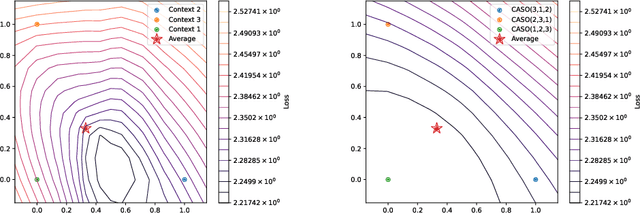

Abstract:Providing Large Language Models with relevant contextual knowledge at inference time has been shown to greatly improve the quality of their generations. This is often achieved by prepending informative passages of text, or 'contexts', retrieved from external knowledge bases to their input. However, processing additional contexts online incurs significant computation costs that scale with their length. State Space Models (SSMs) offer a promising solution by allowing a database of contexts to be mapped onto fixed-dimensional states from which to start the generation. A key challenge arises when attempting to leverage information present across multiple contexts, since there is no straightforward way to condition generation on multiple independent states in existing SSMs. To address this, we leverage a simple mathematical relation derived from SSM dynamics to compose multiple states into one that efficiently approximates the effect of concatenating textual contexts. Since the temporal ordering of contexts can often be uninformative, we enforce permutation-invariance by efficiently averaging states obtained via our composition algorithm across all possible context orderings. We evaluate our resulting method on WikiText and MSMARCO in both zero-shot and fine-tuned settings, and show that we can match the strongest performing baseline while enjoying on average 5.4x speedup.
Descriminative-Generative Custom Tokens for Vision-Language Models
Feb 17, 2025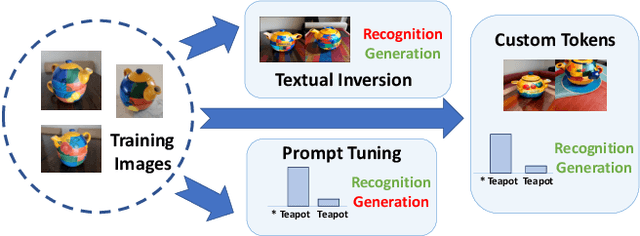

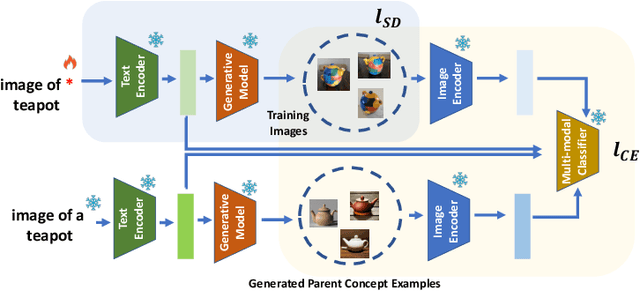

Abstract:This paper explores the possibility of learning custom tokens for representing new concepts in Vision-Language Models (VLMs). Our aim is to learn tokens that can be effective for both discriminative and generative tasks while composing well with words to form new input queries. The targeted concept is specified in terms of a small set of images and a parent concept described using text. We operate on CLIP text features and propose to use a combination of a textual inversion loss and a classification loss to ensure that text features of the learned token are aligned with image features of the concept in the CLIP embedding space. We restrict the learned token to a low-dimensional subspace spanned by tokens for attributes that are appropriate for the given super-class. These modifications improve the quality of compositions of the learned token with natural language for generating new scenes. Further, we show that learned custom tokens can be used to form queries for text-to-image retrieval task, and also have the important benefit that composite queries can be visualized to ensure that the desired concept is faithfully encoded. Based on this, we introduce the method of Generation Aided Image Retrieval, where the query is modified at inference time to better suit the search intent. On the DeepFashion2 dataset, our method improves Mean Reciprocal Retrieval (MRR) over relevant baselines by 7%.
Compositional Structures in Neural Embedding and Interaction Decompositions
Jul 12, 2024
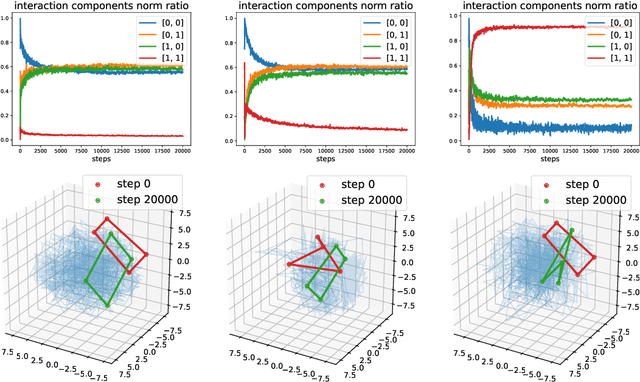
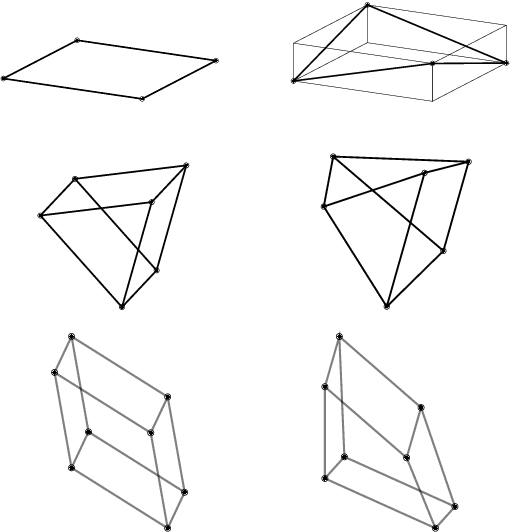
Abstract:We describe a basic correspondence between linear algebraic structures within vector embeddings in artificial neural networks and conditional independence constraints on the probability distributions modeled by these networks. Our framework aims to shed light on the emergence of structural patterns in data representations, a phenomenon widely acknowledged but arguably still lacking a solid formal grounding. Specifically, we introduce a characterization of compositional structures in terms of "interaction decompositions," and we establish necessary and sufficient conditions for the presence of such structures within the representations of a model.
B'MOJO: Hybrid State Space Realizations of Foundation Models with Eidetic and Fading Memory
Jul 08, 2024Abstract:We describe a family of architectures to support transductive inference by allowing memory to grow to a finite but a-priori unknown bound while making efficient use of finite resources for inference. Current architectures use such resources to represent data either eidetically over a finite span ("context" in Transformers), or fading over an infinite span (in State Space Models, or SSMs). Recent hybrid architectures have combined eidetic and fading memory, but with limitations that do not allow the designer or the learning process to seamlessly modulate the two, nor to extend the eidetic memory span. We leverage ideas from Stochastic Realization Theory to develop a class of models called B'MOJO to seamlessly combine eidetic and fading memory within an elementary composable module. The overall architecture can be used to implement models that can access short-term eidetic memory "in-context," permanent structural memory "in-weights," fading memory "in-state," and long-term eidetic memory "in-storage" by natively incorporating retrieval from an asynchronously updated memory. We show that Transformers, existing SSMs such as Mamba, and hybrid architectures such as Jamba are special cases of B'MOJO and describe a basic implementation, to be open sourced, that can be stacked and scaled efficiently in hardware. We test B'MOJO on transductive inference tasks, such as associative recall, where it outperforms existing SSMs and Hybrid models; as a baseline, we test ordinary language modeling where B'MOJO achieves perplexity comparable to similarly-sized Transformers and SSMs up to 1.4B parameters, while being up to 10% faster to train. Finally, we show that B'MOJO's ability to modulate eidetic and fading memory results in better inference on longer sequences tested up to 32K tokens, four-fold the length of the longest sequences seen during training.
Diffusion Soup: Model Merging for Text-to-Image Diffusion Models
Jun 12, 2024



Abstract:We present Diffusion Soup, a compartmentalization method for Text-to-Image Generation that averages the weights of diffusion models trained on sharded data. By construction, our approach enables training-free continual learning and unlearning with no additional memory or inference costs, since models corresponding to data shards can be added or removed by re-averaging. We show that Diffusion Soup samples from a point in weight space that approximates the geometric mean of the distributions of constituent datasets, which offers anti-memorization guarantees and enables zero-shot style mixing. Empirically, Diffusion Soup outperforms a paragon model trained on the union of all data shards and achieves a 30% improvement in Image Reward (.34 $\to$ .44) on domain sharded data, and a 59% improvement in IR (.37 $\to$ .59) on aesthetic data. In both cases, souping also prevails in TIFA score (respectively, 85.5 $\to$ 86.5 and 85.6 $\to$ 86.8). We demonstrate robust unlearning -- removing any individual domain shard only lowers performance by 1% in IR (.45 $\to$ .44) -- and validate our theoretical insights on anti-memorization using real data. Finally, we showcase Diffusion Soup's ability to blend the distinct styles of models finetuned on different shards, resulting in the zero-shot generation of hybrid styles.
Principles of Designing Robust Remote Face Anti-Spoofing Systems
Jun 06, 2024

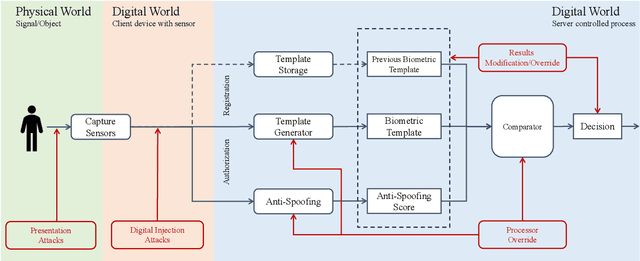

Abstract:Protecting digital identities of human face from various attack vectors is paramount, and face anti-spoofing plays a crucial role in this endeavor. Current approaches primarily focus on detecting spoofing attempts within individual frames to detect presentation attacks. However, the emergence of hyper-realistic generative models capable of real-time operation has heightened the risk of digitally generated attacks. In light of these evolving threats, this paper aims to address two key aspects. First, it sheds light on the vulnerabilities of state-of-the-art face anti-spoofing methods against digital attacks. Second, it presents a comprehensive taxonomy of common threats encountered in face anti-spoofing systems. Through a series of experiments, we demonstrate the limitations of current face anti-spoofing detection techniques and their failure to generalize to novel digital attack scenarios. Notably, the existing models struggle with digital injection attacks including adversarial noise, realistic deepfake attacks, and digital replay attacks. To aid in the design and implementation of robust face anti-spoofing systems resilient to these emerging vulnerabilities, the paper proposes key design principles from model accuracy and robustness to pipeline robustness and even platform robustness. Especially, we suggest to implement the proactive face anti-spoofing system using active sensors to significant reduce the risks for unseen attack vectors and improve the user experience.
NeRF-Insert: 3D Local Editing with Multimodal Control Signals
Apr 30, 2024



Abstract:We propose NeRF-Insert, a NeRF editing framework that allows users to make high-quality local edits with a flexible level of control. Unlike previous work that relied on image-to-image models, we cast scene editing as an in-painting problem, which encourages the global structure of the scene to be preserved. Moreover, while most existing methods use only textual prompts to condition edits, our framework accepts a combination of inputs of different modalities as reference. More precisely, a user may provide a combination of textual and visual inputs including images, CAD models, and binary image masks for specifying a 3D region. We use generic image generation models to in-paint the scene from multiple viewpoints, and lift the local edits to a 3D-consistent NeRF edit. Compared to previous methods, our results show better visual quality and also maintain stronger consistency with the original NeRF.
CPR: Retrieval Augmented Generation for Copyright Protection
Mar 27, 2024Abstract:Retrieval Augmented Generation (RAG) is emerging as a flexible and robust technique to adapt models to private users data without training, to handle credit attribution, and to allow efficient machine unlearning at scale. However, RAG techniques for image generation may lead to parts of the retrieved samples being copied in the model's output. To reduce risks of leaking private information contained in the retrieved set, we introduce Copy-Protected generation with Retrieval (CPR), a new method for RAG with strong copyright protection guarantees in a mixed-private setting for diffusion models.CPR allows to condition the output of diffusion models on a set of retrieved images, while also guaranteeing that unique identifiable information about those example is not exposed in the generated outputs. In particular, it does so by sampling from a mixture of public (safe) distribution and private (user) distribution by merging their diffusion scores at inference. We prove that CPR satisfies Near Access Freeness (NAF) which bounds the amount of information an attacker may be able to extract from the generated images. We provide two algorithms for copyright protection, CPR-KL and CPR-Choose. Unlike previously proposed rejection-sampling-based NAF methods, our methods enable efficient copyright-protected sampling with a single run of backward diffusion. We show that our method can be applied to any pre-trained conditional diffusion model, such as Stable Diffusion or unCLIP. In particular, we empirically show that applying CPR on top of unCLIP improves quality and text-to-image alignment of the generated results (81.4 to 83.17 on TIFA benchmark), while enabling credit attribution, copy-right protection, and deterministic, constant time, unlearning.
Multi-Modal Hallucination Control by Visual Information Grounding
Mar 20, 2024



Abstract:Generative Vision-Language Models (VLMs) are prone to generate plausible-sounding textual answers that, however, are not always grounded in the input image. We investigate this phenomenon, usually referred to as "hallucination" and show that it stems from an excessive reliance on the language prior. In particular, we show that as more tokens are generated, the reliance on the visual prompt decreases, and this behavior strongly correlates with the emergence of hallucinations. To reduce hallucinations, we introduce Multi-Modal Mutual-Information Decoding (M3ID), a new sampling method for prompt amplification. M3ID amplifies the influence of the reference image over the language prior, hence favoring the generation of tokens with higher mutual information with the visual prompt. M3ID can be applied to any pre-trained autoregressive VLM at inference time without necessitating further training and with minimal computational overhead. If training is an option, we show that M3ID can be paired with Direct Preference Optimization (DPO) to improve the model's reliance on the prompt image without requiring any labels. Our empirical findings show that our algorithms maintain the fluency and linguistic capabilities of pre-trained VLMs while reducing hallucinations by mitigating visually ungrounded answers. Specifically, for the LLaVA 13B model, M3ID and M3ID+DPO reduce the percentage of hallucinated objects in captioning tasks by 25% and 28%, respectively, and improve the accuracy on VQA benchmarks such as POPE by 21% and 24%.
Interpretable Measures of Conceptual Similarity by Complexity-Constrained Descriptive Auto-Encoding
Feb 14, 2024Abstract:Quantifying the degree of similarity between images is a key copyright issue for image-based machine learning. In legal doctrine however, determining the degree of similarity between works requires subjective analysis, and fact-finders (judges and juries) can demonstrate considerable variability in these subjective judgement calls. Images that are structurally similar can be deemed dissimilar, whereas images of completely different scenes can be deemed similar enough to support a claim of copying. We seek to define and compute a notion of "conceptual similarity" among images that captures high-level relations even among images that do not share repeated elements or visually similar components. The idea is to use a base multi-modal model to generate "explanations" (captions) of visual data at increasing levels of complexity. Then, similarity can be measured by the length of the caption needed to discriminate between the two images: Two highly dissimilar images can be discriminated early in their description, whereas conceptually dissimilar ones will need more detail to be distinguished. We operationalize this definition and show that it correlates with subjective (averaged human evaluation) assessment, and beats existing baselines on both image-to-image and text-to-text similarity benchmarks. Beyond just providing a number, our method also offers interpretability by pointing to the specific level of granularity of the description where the source data are differentiated.
 Add to Chrome
Add to Chrome Add to Firefox
Add to Firefox Add to Edge
Add to Edge